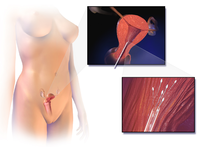
Photo from wikipedia
Is the performance of the postwash total motile sperm count a predictor of pregnancy at the time of intrauterine insemination? The number of motile spermatozoa inseminated (NMSI) in IUI can… Click to show full abstract
Is the performance of the postwash total motile sperm count a predictor of pregnancy at the time of intrauterine insemination? The number of motile spermatozoa inseminated (NMSI) in IUI can be used to define clear range of pre /postwash sperm parameters. There is no consensus about the optimal number of motile spermatozoa inseminated (NMSI) required for a reasonable chance of pregnancy after IUI. A meta-analysis of 16 studies assessing NMSI and IUI outcomes, concluded that at cut-off levels between 0.8 and 5 million, defined as the ability to predict failure to become pregnant. The purpose of this study is to determine the range of NMSI as a predictor of success in IUI. This prospective study includes 60 patients who underwent semen analysis at an academic infertility centre (SRIHER) during the month of December 2020 and January 2021. A total of 60 infertile couples who underwent IUI at our academic centre were enrolled in our study. A detailed history and infertility work up was done before proceeding for IUI, as per the department protocol. The semen was prepared by discontinuous 2 layered density gradient method. The results were analyzed by patient factors including age, BMI, semen parameters, NMSI. The NMSI were divided into 4 groups: A (<1), B (1–4), C (5–9), D (>10). The mean age of the infertile couples who underwent IUI was (28.2 ± 3.8) in females and (31.8 ± 3.8) in males respectively. The sperm parameters such as concentration (21.8 ± 14.8), motility (53.15 ± 13.22), morphology (2.43 ± 1.33) respectively. When the NMSI was group C (5–9 x 10 6) the pregnancy rate was 38.5% whereas the pregnancy rate was 37.5% in group D ( >10 x 10 6). In the other sub groups such as group A(<1 x 10 6) and group C (1–4 x 10 6) the pregnancy rate was 14.2% and 12.5% respectively. Infertile men with Azoospermia, Men with Retrograde ejaculation, Testicular samples, Epididymal samples, Infected samples. All of the above samples were avoided. It cannot be used for counselling during the initial infertility workup, but only during/after the IUI procedure. Wider implications of the findings: The results suggest that NMSI can be a predictor of success in IUI in patients who are < 30 years of age & ≥35 years, NMSI does not appear to be a useful. The effect of NMSI on pregnancy rate needs to evaluated on a larger scale . Not applicable
Journal Title: Human Reproduction
Year Published: 2021
Link to full text (if available)
Share on Social Media: Sign Up to like & get
recommendations!